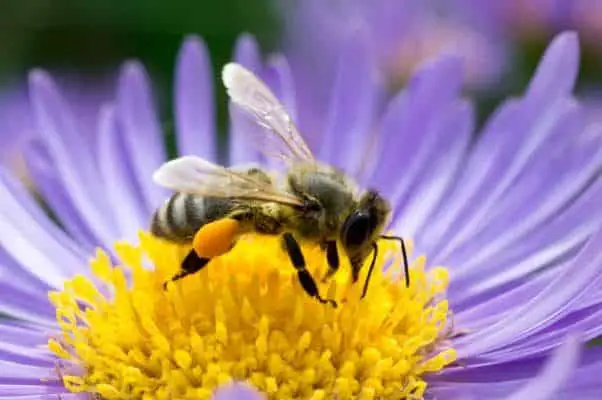
We hear all the time about the importance of bees because they pollinate plants, not just flowers but crops as well. For me this raised the question how do the bees actually pollinate plants?
Bees are purpose built to pollinate flowers. The aroma of the nectar attracts the bees. As bees collect nectar, pollen from the anther (male part) sticks to their body. Moving flower to flower the bees are transferring pollen to the stigma (female part) of the flower. This pollinates the plant.
The diagram below outline how the bees facilitate the process of pollination.
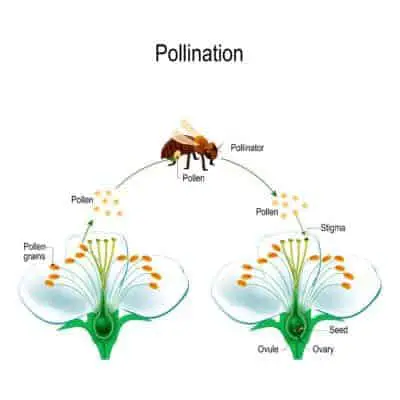
How do flowers attract bees for pollination?
To comprehend this better we need to recognise that not all plants are necessarily trying to attract honey bees. There is more than one way that pollination can occur.
About 12% of plants with flowers don’t actually require pollination from anything else but the wind. These plants rely solely on the wind to blow pollen from the flower and deposit it on another flower in order for fertilization to occur.
Interestingly, these plants often have dull flowers and very little scent. Some aquatic plants rely on water to transfer pollen in order to be pollinated.
The incredible South East Asian flower the Rafflesia is different again and challenges what we stereotypically think of a flower. The Rafflesia flower is the largest in the world, growing up to a staggering 100cm (39.4 inches) in diameter and weighing up to 10kg (22lb). This flower is in no way trying to attract honey bees and you certainly won’t see it in a floral bouquet at your local florist.
Check out this picture of one. They look cool but maybe not so nice on the nostrils.
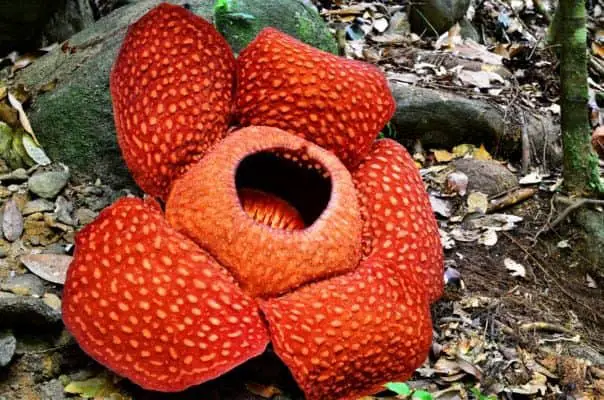
Shockingly it looks and smells like rotting flesh. The Rafflesia flower attracts flies which fly from flower to flower looking to lay eggs and in turn distributing pollen amongst the flowers resulting in pollination.
The remaining 70% to 80% of flowers require pollination by insects, making the honey bee the true super heros. Not only are they unbelievably efficient at collecting and distributing pollen as the move from flower to flower, they are also like heat seeking missiles when it comes to locating and targeting flowers to pollinate. On top of this they are team players and can very accurately communicate the location of the flowers to other bees from their hive. It is not uncommon to see large flowering trees with literally thousands of bees collectively gathering pollen and nectar.
Inherently there are three key characteristics that plants use to attract or even distracted certain pollinators. They are:
- Color
- Scent
- Shape
Flower Color
The color of the flower can be a distinct enticement to certain types of pollinators. Typically birds are attracted to bright colors, commonly those with red and yellow flowers.
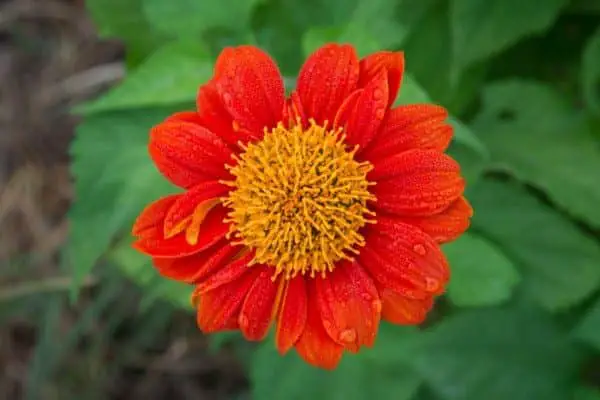
More often than not, honey bees are attracted to shades of blue, white, and yellow flowers.
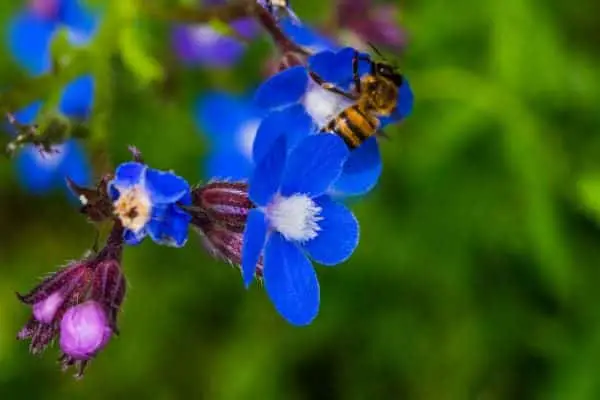
Some plants even have a secret weapon for attracting honey bees. The flowers on these plants have unique markings that absorb and reflect ultraviolet light. Bees can spot the ultraviolet light like a beacon attracting them to the sweet nectar inside the flower.
The image below is what a white Gerbera like under ultraviolet light.
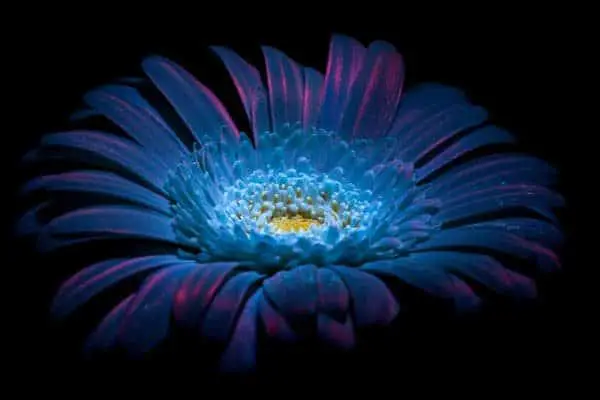
Flower Scent
For most pollinators the common prize they are all seeking is the nectar inside the flower. Honey bees have a strikingly acute sense of smell with a staggering 170 odor receptors located in their antennae. The odor receptors have the ability to zero in on a target scent allowing the bees to not only distinguish the type of flower they want but the direction the flower is in. They can do all of this mid flight, making bees dynamically efficient in finding nectar and pollen.
The scent of the nectar usually comes from deep within the flower. The flowers anthers and stigmas are positioned in such a way that as the bee climbs into the flower they brush past these vital parts. This process will not only collect pollen but drop pollen from the small hairs on their bodies, in turn pollinating the plant.
It is usual that there is enough nectar for countless bees ensuring a high probability of effective pollination of the flower. Interestingly birds typically have a poor sense of smell meaning the sweet scent of nectar is not the primary attraction for them, it is in fact the colour.
Flower Shape
The shape of a flower can not only influence how pollination occurs but also the types of pollinators it attracts. For example, long tubular flowers where the nectar is located deep within the flower are ideal for nectar eating birds from the Meliphagidae family. These birds are able to submerge their beaks into the flower.
Large open flowers such as sunflowers have a large, exposed circumference making way for a multitude of bees to collectively gather nectar and pollen at the same time.
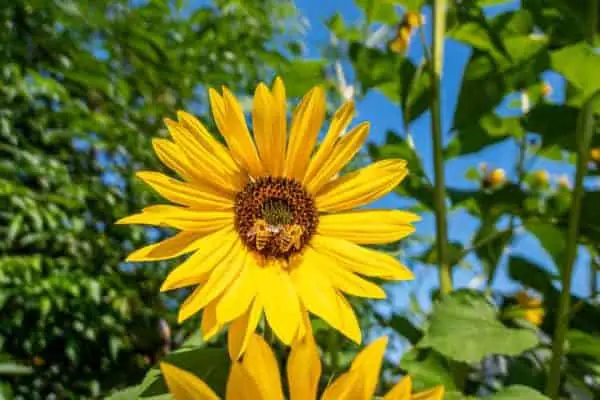
It’s common practice for farmers of sunflowers to contract beekeepers to bring in hives as a safeguard ensuring big plantations of sunflowers are suitably pollinated.
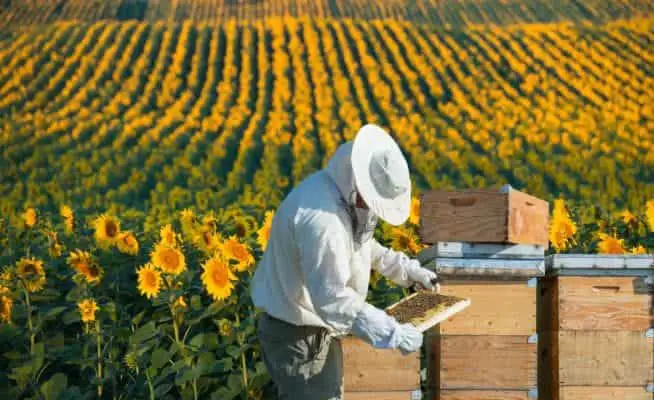
Pea shaped flowers typically have a top petal called a banner, two bottom petals called a keel and side petals called wings. When the bees enter into the middle of the flower her weight on the keel petals causes the anthers and stigma brush against the bee’s body promoting the transfer of pollen both ways via the hair on the bee’s body.
How do bees collect the pollen?
The worker bees body is covered in fine hair. The pollen from the flowers the bees visit sticks to these hairs. The bee then grooms herself with her legs. The grooming process pushes the collected pollen into the bees “pollen baskets” located on her back legs. The pollen collection area on the bees legs look like little baskets. They are made up of a bundle of long stiff hairs.
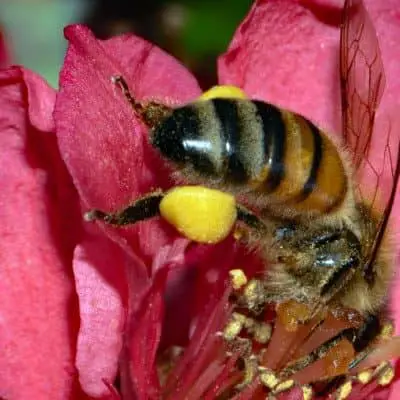
Why do bees pollinate flowers?
It is not the bees specific intention to pollinate the flowers. The bees are lured to the flower by the sweet scent of the nectar on offer, they crawl deep inside of the flower draw in their prize with their proboscis or tongue. In the process of foraging for the nectar they come in contact with the male part of the flower called the anther. This is where the grains of pollen from the male plant cells are discharged and stick to the body of the bee.
This has meaningful health benefits for the bee as the pollen is a vital protein source for their hive. At the same time the worker bee is also coming in contact with the stigma, the female part of the flower. This is where pollen grains from other flowers the bee has visited are attaching and fertilizing the flower.
When the bees honey sack called the “crop” is full they will groom the excess pollen into their pollen baskets and return to the hive where the pollen and nectar provides rich resources for the hive.
What happens if a plant is not pollinated?
For a plant, pollination is the process that secures reproduction of future generations of their species. Plants do this by producing seeds, some plants can produce millions of seeds during a season while others relatively few.
While no one species is the same, one thing they collectively have in common is they all have to produce the seeds. In order for this to occur they need their flowers to be pollinated. Some flowers can self pollinate to produce their seeds while and others need to be cross-pollinated by the wind, birds, bees or other insects or a seed will not form.
It is fairly easy to tell if fruit and vegetables have had poor or incomplete pollination of their flowers. The evidence of this will be seen in the fruit.
The flesh of the fruit is customarily there to protect the seed of the plant. If the flower is not pollinated or only partially pollinated the flesh around the seed will form an odd shape, be inconsistent in size or underdeveloped, and won’t ripen properly resulting in impoverished fruit.
Check out these strawberry, they are a good example of poor pollination.
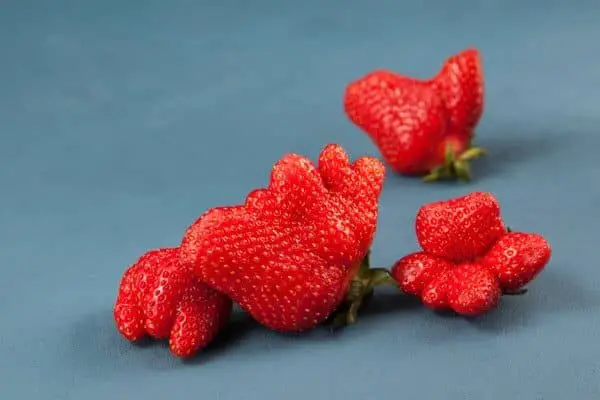
You can see why bees are so important for farmers whose livelihood relies on the pollination process to produce desirable produce fit for consumption.
For some plants proper pollination is critical. In some cases no seed at all is produced if pollination is not successful. Almonds are an example of this. For this reason in California, the largest almond growing area in the world with over 1 million acres of crops in 2018 contracted almost 2 million beehives from beekeepers to ensure their trees were properly pollenatied.
Popular self pollinating plants that you might eat from include:
- Tomatoes
- Peanuts
- Green peppers
- Chilli peppers
- Lima beans
Popular wind pollinated plants that we eat from include:
- Corn
- Soybean
- Rice
- Sorghum
- Wheat
Honey bees are particularly critical to the pollination of the crops listed below. Farmers have will hire beekeepers to provide bee hives to ensure consistent pollination and superior yielding crops.
- Almonds
- Apples
- Blueberries
- Watermelons
- Cucumbers
- Cranberries
Gaining an understanding on how bees pollinate plants acutely highlights how crucial a role they play in nature. Whilst there are other insects, birds and even the wind administering pollination for some species of plants, the humble honey bee is undoubtedly the biggest contributor to pollination worldwide.
It is not surprising that the honey bees were declared the “most important living being earth”. I hope you are encouraged to do all that we can to help these incredible creatures thrive.
